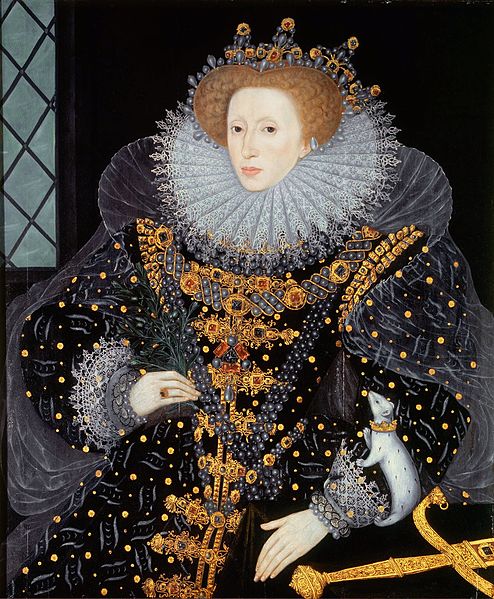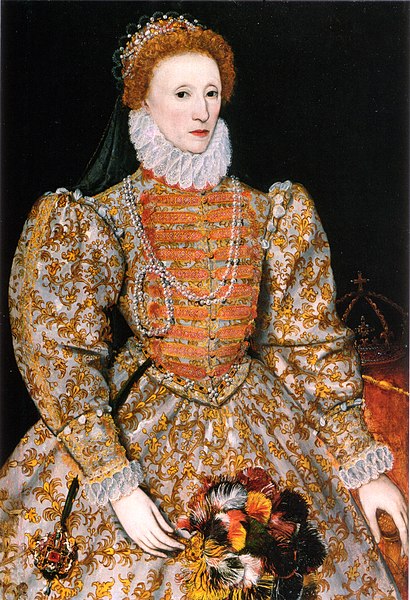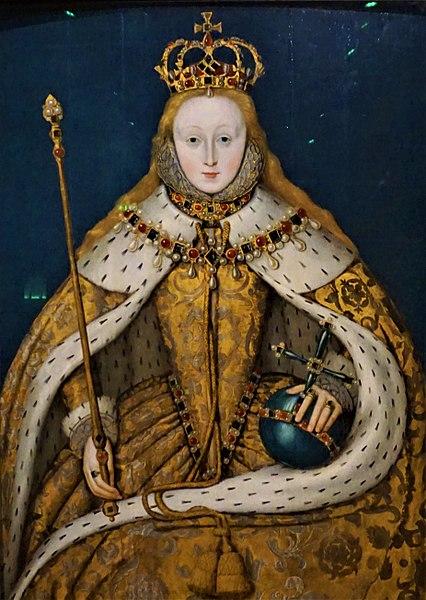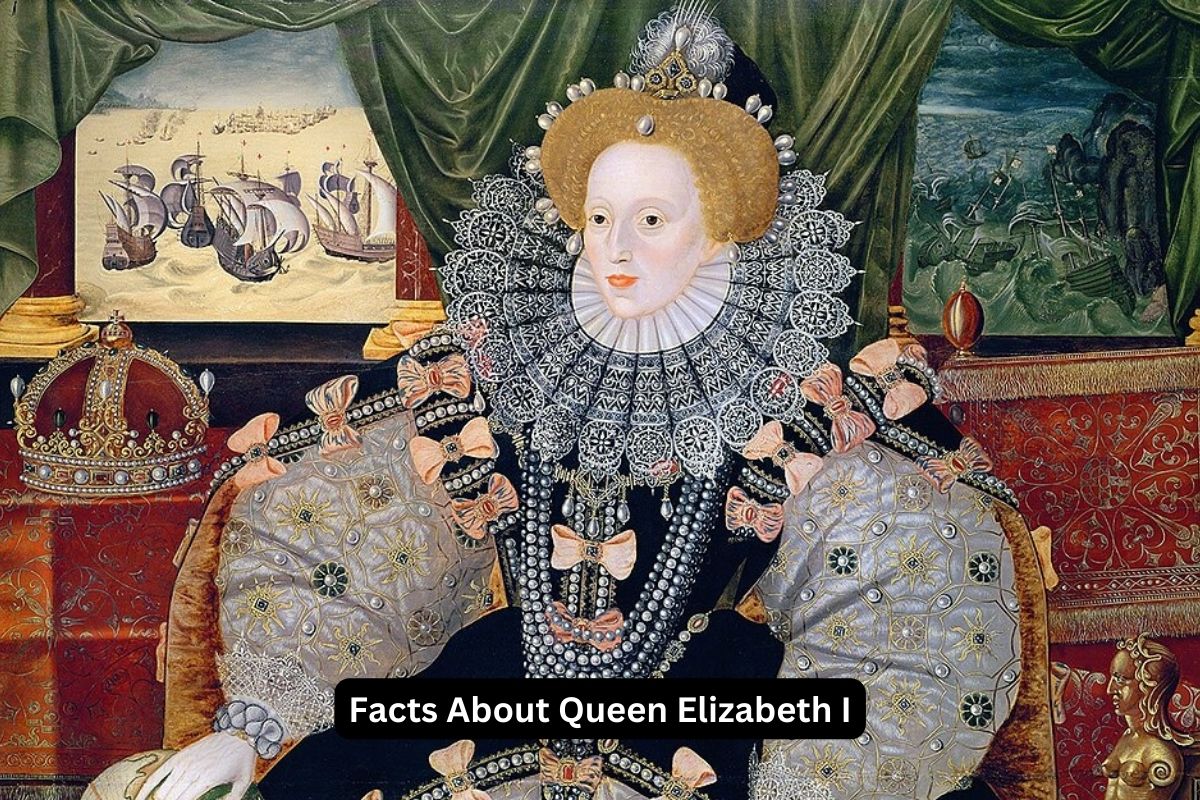Queen Elizabeth I, born in 1533, was the daughter of King Henry VIII and Anne Boleyn. She ascended to the throne in 1558, marking the beginning of the Elizabethan Era, a celebrated period in English history known for cultural achievements, including the works of William Shakespeare.
Elizabeth’s reign is also notable for the defeat of the Spanish Armada in 1588, which solidified England’s status as a world power.
She never married, earning her the nickname “Virgin Queen,” and ruled for 45 years until her death in 1603.
Her legacy includes shaping the Church of England through the Elizabethan Religious Settlement and her lasting impact on England’s cultural and political development.
Queen Elizabeth I Facts
1. Known as the “Virgin Queen” because she never married
Queen Elizabeth I is often referred to as the “Virgin Queen” because she never married or had children during her reign.
Her decision to remain single was a strategic one. Marrying a foreign prince or noble could have caused political instability or interference in English affairs.
Also Read: Facts About the Elizabethan Era
Elizabeth stated that she was married to her kingdom and the welfare of her people, and her unmarried status became an enduring aspect of her identity and rule.

2. Reigned for 44 years, making her one of England’s longest-reigning monarchs
Elizabeth I’s reign is remarkable for its duration, lasting for 44 years and 127 days. She ascended to the throne on November 17, 1558, and ruled until her death on March 24, 1603.
Also Read: Accomplishments of Queen Elizabeth I
This extended reign allowed her to establish stability and consolidate power in England, contributing to the relative peace and prosperity of her era. Her reign surpassed those of her predecessors and laid the groundwork for England’s future as a formidable world power.
3. Her reign is associated with the “Golden Age” of English literature and the arts
Queen Elizabeth I’s reign is often celebrated as the “Elizabethan Era” or the “Golden Age” of English history. This period, roughly spanning from the late 16th century to the early 17th century, was marked by significant achievements in various fields.
- Literature: The Elizabethan era witnessed the flourishing of English literature with the works of famous playwrights and poets like William Shakespeare, Christopher Marlowe, and Ben Jonson. Shakespeare, in particular, produced some of his most renowned plays during this time.
- Exploration: The era was characterized by notable exploration endeavors. Sir Walter Raleigh sponsored voyages to the New World, and Sir Francis Drake circumnavigated the globe. These explorations contributed to England’s global influence and the growth of the British Empire.
- Arts: Beyond literature, the arts flourished in the Elizabethan era. The period saw advancements in music, architecture, and visual arts. Elaborate court masques, for example, showcased the creativity and cultural richness of the time.
- Political Stability: Queen Elizabeth I’s leadership brought relative stability to England after the tumultuous reigns of her predecessors, including her sister, Queen Mary I. Her skillful diplomacy and management of religious conflicts contributed to this stability.
4. Defeated the Spanish Armada in 1588
One of the most famous events during Queen Elizabeth I’s reign was the defeat of the Spanish Armada in 1588. The Spanish Armada was a formidable naval fleet sent by King Philip II of Spain to invade England and overthrow Protestantism.
Elizabeth’s forces, led by skilled naval commanders like Sir Francis Drake, Sir John Hawkins, and Charles Howard, Lord Admiral of England, successfully repelled the Spanish invasion.
- Tactics and Strategy: The English employed innovative tactics and strategies, including the use of smaller, more maneuverable ships known as “Elizabethan Galleons.” They used fire ships, sending burning vessels into the heart of the Armada, causing panic and confusion among the Spanish fleet.
- Weather: A stroke of luck for the English was a series of storms in the North Sea known as the “Protestant Wind.” This natural event scattered and damaged the Armada, contributing to its defeat.
- Impact: The defeat of the Spanish Armada was a pivotal moment in English history. It not only preserved England’s independence and Protestant faith but also established England as a formidable naval power. It marked the decline of Spain’s naval dominance and the rise of the British Empire.

5. Established the Church of England through the Elizabethan Religious Settlement
Queen Elizabeth I’s reign saw the implementation of the Elizabethan Religious Settlement in 1559. This was a pivotal event in English history as it aimed to bring stability and unity to the religious landscape, which had been highly contentious during the reigns of her predecessors.
- Establishment of the Church of England: The settlement established the Church of England as the official state religion. It was a compromise between Catholicism and Protestantism, with many elements of Catholic worship and doctrine retained, but with the monarch as the Supreme Governor of the Church.
- Religious Toleration: The Elizabethan Religious Settlement allowed for a degree of religious toleration, as long as individuals outwardly complied with the Church of England’s practices. This helped reduce religious persecution and tensions.
- Stability and Reconciliation: The settlement aimed to bring stability and reconciliation to a nation torn apart by religious conflict during the reigns of Henry VIII, Edward VI, and Mary I. It played a crucial role in creating a religiously unified England, at least in outward appearance.
6. Had an efficient administrative system with key advisors like Sir William Cecil
Queen Elizabeth I’s reign was marked by a highly efficient administrative system, which was essential for the stability and success of her rule.
- Sir William Cecil (Lord Burghley): Elizabeth’s chief advisor, Sir William Cecil, played a key role in managing the kingdom’s affairs. He was a skilled statesman who helped shape Elizabethan policies, including the Religious Settlement and the management of finances.
- Privy Council: Elizabeth relied on a Privy Council made up of trusted advisors to assist in governing the country. This council provided expertise and guidance on various matters, ensuring the smooth functioning of the government.
- Management of Finances: Elizabeth and her advisors managed the kingdom’s finances efficiently, which was crucial for the stability of the realm. This included efforts to reduce debt and maintain a balanced budget.

7. Enacted the Elizabethan Poor Law in 1601, laying the foundation for the welfare system
The Elizabethan Poor Law of 1601 was a significant piece of legislation during Queen Elizabeth I’s reign. This law established a framework for the care of the poor and needy in England and is often considered a precursor to the modern welfare system.
- Key Provisions: The Elizabethan Poor Law required parishes to levy taxes to support the poor and provide for their basic needs, such as food, shelter, and clothing. It established a system of “overseers of the poor” to administer relief and make sure the law was enforced.
- Local Responsibility: The law placed the responsibility for caring for the poor on individual parishes, making it a local matter. This decentralized approach aimed to address poverty at the community level.
- Legacy: The Elizabethan Poor Law laid the foundation for the development of the English poor relief system, which evolved over time into the modern welfare state. It reflected Queen Elizabeth I’s concern for the welfare of her subjects and sought to address the growing problem of poverty during her reign.
8. Famous for her inspiring speeches, including the one at Tilbury in 1588
Queen Elizabeth I was renowned for her eloquent and inspirational speeches. One of her most famous speeches was delivered in 1588 at Tilbury, where she addressed her troops in preparation for the expected Spanish invasion.
- Tilbury Speech: In her Tilbury speech, Elizabeth famously declared, “I know I have the body but of a weak and feeble woman; but I have the heart and stomach of a king.” She expressed her unwavering determination and readiness to lead her country in times of crisis.
- Rallying the Troops: Elizabeth’s speech at Tilbury was a masterful display of leadership and motivation. It boosted the morale of her troops and solidified their loyalty to their queen and country.
9. Her portraits often contained symbolic elements, like the “Rainbow Portrait”
One of the most iconic portraits of Queen Elizabeth I is the “Rainbow Portrait.” This painting, created around 1600, is rich in symbolism and captures the essence of Elizabethan rule.
- Symbolism: The “Rainbow Portrait” features Queen Elizabeth I wearing a gown adorned with eyes and ears, symbolizing her vigilance and wisdom as a ruler. The rainbow in the background represents peace and hope, reinforcing her role as a stabilizing force in England.
- Flattery and Propaganda: Portraits of the queen were often used as political propaganda during her reign. The “Rainbow Portrait” was intended to flatter and portray Elizabeth as a wise and divinely chosen monarch.
- Artistic Expression: The portrait reflects the artistic creativity of the Elizabethan era, which produced numerous iconic works of art and literature.
10. Her reign left a lasting impact on England’s status as a world power
Queen Elizabeth I’s reign left a lasting legacy on England and its place in the world.
- Strengthening of England: Under Elizabeth’s leadership, England’s power and influence grew. Her reign is associated with the expansion of English exploration, trade, and colonization efforts.
- Cultural Flourishing: The Elizabethan era was marked by a flourishing of English literature and the arts. This period produced some of the greatest works in the English language, with playwrights like William Shakespeare achieving international acclaim.
- National Pride: Elizabeth’s reign instilled a sense of national pride in the English people. Her skillful diplomacy and the defeat of the Spanish Armada were seen as triumphs for England, bolstering its reputation on the world stage.
Queen Elizabeth I’s reign witnessed the enactment of important social legislation, memorable speeches, iconic portraits, and a lasting legacy of cultural and political significance. Her rule played a pivotal role in shaping the course of English and world history during the Elizabethan Era.
